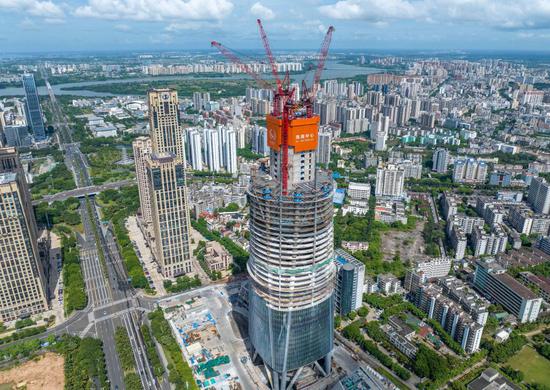President Xi Jinping has called for the enhanced utilization of a new cross-sea passage connecting two cities in South China's Guangdong province to drive the advancement of the Guangdong-Hong Kong-Macao Greater Bay Area.
Xi, who is also general secretary of the Communist Party of China Central Committee and chairman of the Central Military Commission, made the remark on Sunday in a letter sent to congratulate the unveiling of the Shenzhen-Zhongshan Link.
The 24-kilometer cross-sea passage, which features two bridges, two artificial islands and an underwater tunnel, opened to traffic at 3 pm on Sunday.
The link, bridging Shenzhen in the east of the Pearl River Estuary with Zhongshan in the west, has significantly reduced travel time between the two cities from about two hours to under 30 minutes.
Xi said the massive transportation project managed to overcome numerous global-level technical challenges and set multiple world records.
"This fully illustrates that Chinese modernization can only be achieved through solid work, as all great causes are accomplished through concrete actions," he said, while extending congratulations to all participants for their diligent efforts and unwavering resolve in successfully completing the project with high quality.
The Shenzhen-Zhongshan Link features eight lanes designed for speeds of up to 100 kilometers per hour. The one-way toll fee is 66 yuan.
The Shenzhen-Zhongshan Link — a large-scale transportation project in the Greater Bay Area after the 31-km Hong Kong-Zhuhai-Macao Bridge — is one of the world's most challenging cross-sea cluster projects to have been built.
Over 10,000 workers overcame hurdles such as frequent typhoons, high salinity, humidity and severe siltation during the course of its seven-year construction. The project set multiple world records in areas such as suspension bridge engineering, tunnel construction and underwater highway interchanges.
The new link will enhance regional development and competitiveness, bridging the economic gap between the eastern and western shores of the Pearl River Estuary and facilitating leisure travel, experts said.
Li Hui, an assistant professor at the School of Media and Communication at Shenzhen University, underscored the significance of the transportation cluster in propelling development of the Greater Bay Area.
"It has not only reduced physical distance, but also — and more importantly — provided a sense of psychological proximity. It exemplifies a deeper integration of the Greater Bay Area," Li said, noting that the link effectively blurs urban boundaries and fosters a closer life-work environment.
Drawing parallels between the two key transportation links in the Greater Bay Area and the iconic Golden Gate Bridge in the San Francisco Bay Area in the United States, Li expressed confidence that advancements in the Greater Bay Area would enhance social equity, balance regional progress, and facilitate overall development.
Ning Jinjin, an engineer involved in the construction of the undersea tunnel, expressed gratitude and pride for having been able to contribute to the Shenzhen-Zhongshan Link.
"For engineers, the challenges encountered in projects are fundamentally straightforward — it's about progressing through the process of identifying and resolving issues, a simple cyclical approach," he said.
The new cross-sea link promises to enhance the lives of millions of people in the Greater Bay Area and beyond, local residents said.
Yang Nan, a researcher at a medical institute in Zhongshan, said she is often required to travel to Shenzhen for academic exchanges, a journey that typically took over two hours by car until now.
"There was constant traffic congestion along the highway, despite the relatively short distance between Shenzhen and Zhongshan," she said.
With the opening of the new link, Yang said she hopes to take cross-city buses or drive to Shenzhen more frequently.
Shenzhen resident Huang Mu, who has a cousin living in Zhongshan, also highlighted the benefits of the new link.
"Previously, we had to take a detour via Humen Bridge to go to Zhongshan, where traffic congestion, especially during the holidays, often resulted in trips taking over three hours, which sometimes hindered my visits," she said.
Huang added that she plans to take the new link to visit her cousin as soon as her son's summer vacation starts. "This is excellent news for all of us."


















































 京公网安备 11010202009201号
京公网安备 11010202009201号